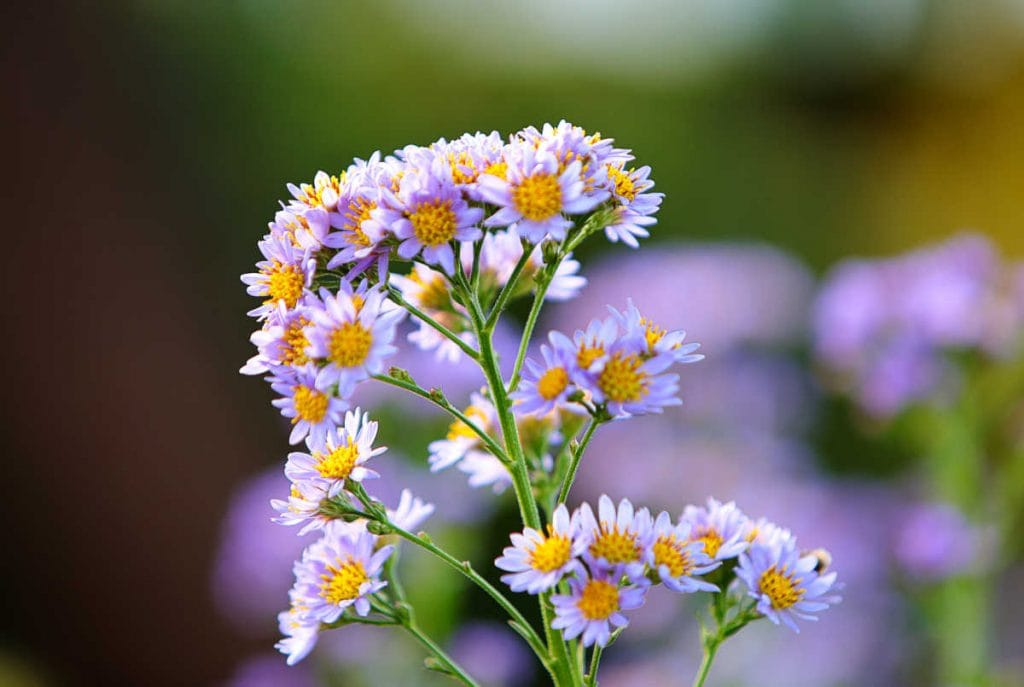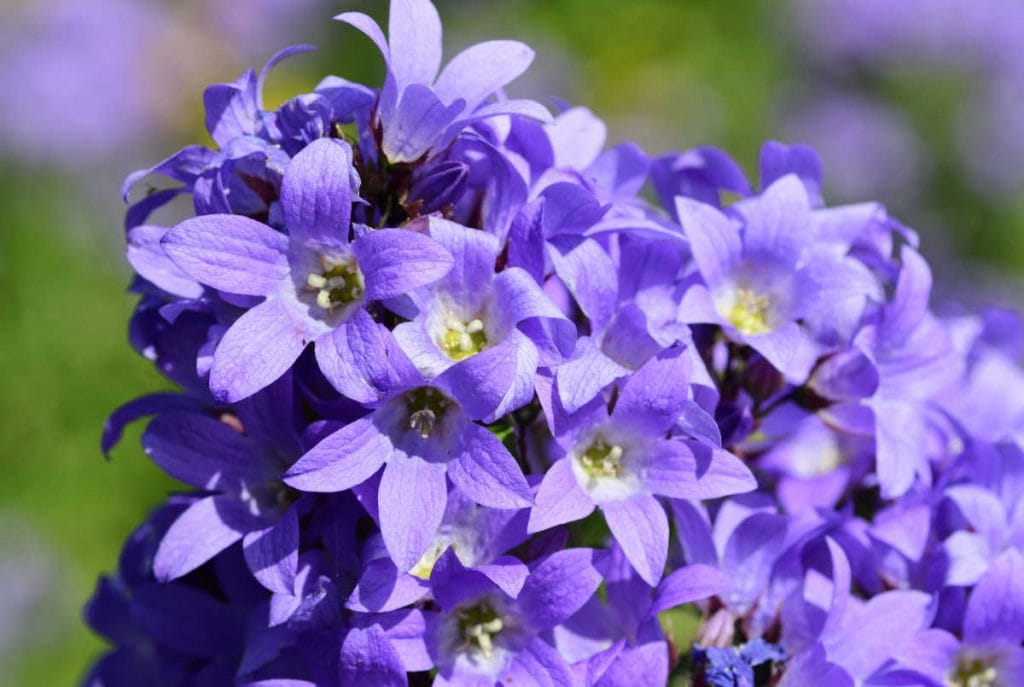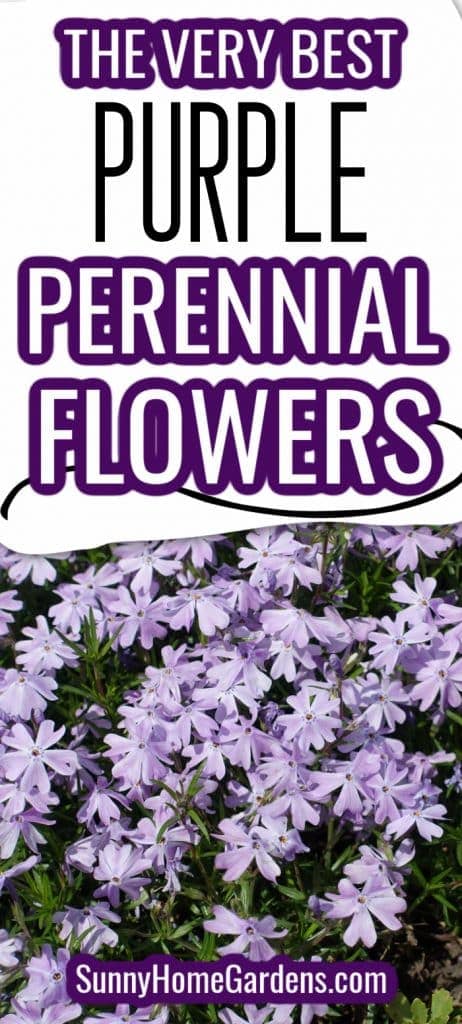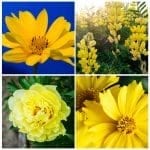Purple is one of my favorite colors and I love seeing purple flowers. If purple is your favorite color as well, you’ll be happy to know there are a large variety of purple perennial flowers you can plant in your garden.
For starters, purple is a soothing color and comes in various shades from light to dark.
These purple flowers can be paired up with other shades of purple perennials, or you can mix it up and add white, yellow, pink, or other colored flowers to your garden.
Let’s dig in to the purple perennial flowers that you’ll want to add to your yard and garden.
Table of Contents
Best Purple Perennials
Every flower listed will add a certain element to your garden.
Some will attract bees and butterflies, while others are known to have amazing scents.
Each flower is special in its own way and will make a great addition to your flower bed.
Purple perennial flowers come in different heights. Here we have divided our list of purple perennials based on their heights.
Short Purple Perennial Flowers
Creeping Thyme

Creeping Thyme is perfect for a ground cover with a bit of people walking through.
Doing best in zones 4-9, this attractive flower is a durable plant. Growing 2-3 inches tall, the plant will be 12 to 15 inches wide.
It makes a border in gardens or works nicely for cottage or rock gardens.
Getting these seeds started can be difficult, so you’ll need to baby them a bit. You may want to buy plugs of these if you aren’t an experienced gardener or prefer the ease of not starting these from seed. These flowers do best in full sun with well-draining soil.
The lush foliage contains deep green leaves that are shiny with a mass of small purple flowers with dark veins.
RELATED: Yellow Perennial Flowers to Add to Your Flower Beds
RELATED: Beautiful Flowers that Bloom at Night
Medium Height Purple Perennial Flowers
Lavender (Lavandula Species)

Best known for its fragrant scent, lavender is often used for essential oils once harvested.
This sun-loving plant is deer resistant. Lavender does best in zones 5 to 9 and requires full sun exposure. It does need well-drained soil in order to thrive.
These graceful flowers are produced on spikes or shoots with either simple or pinnate leaves.
Lavender is very hardy and can last 20 to 30 years. Many use lavender for decoration in the homes. It can be cooked with or used to make lavender sugar.
There are approximately 39 species in the Lavandula group. Here are some of the more common species:
* English Lavender- Very aromatic, this flower produces blooms that are 2 to 3 feet upright in clumps. Blooming early to mid-summer, this beauty is great for borders, rock gardens, raised walls, walkways, and more.
* French Lavender- Doing best in zones 8 to 9, these flowers bloom early summer to fall nonstop. While their spikes are very colorful, they are not as fragrant as other types of Lavender. They get between 12 to 36 inches tall.
* Portuguese Lavender- This adorable flower has long stems with pale lilac flowers with coarse evergreen leaves. It is a pungent flower that blooms from late spring to late summer and will grow one to three feet tall. It is hardy in zones 6 to 8.
* Spanish Lavender- Also known as Butterfly Lavender, this flower is used in essential oils and potpourri. They bloom mid-spring to late summer and are 18 to 24-inch mounds. While the flowers are not aromatic, the foliage that accompanies them is. This type of lavender does well in containers or as a ground cover.
SALVIA (SALVIA NEMOROSA)

Commonly known as sage, this plant grows best in zones 4 to 8. It generally grows up to 2 feet high and will spread this far as well. Salvia blooms from June to September.
Its blue-violet flowers are fragrant and attract butterflies. With skinny spikes and square stems, Salvia is deer resistant. This hardy plant is easy to grow and is an attractive addition to any garden.
DAYLILY
The Daylily is 1 to 3 feet in height depending upon the variety. They thrive in zones 3 to 9.
These flowers can withstand a variety of soil conditions.
With sword-shaped leaves and trumpet-shaped blossoms, these flowers bloom every day over a span of time. As one flower dies off, a new one opens. For this reason, the plant can bloom for weeks or even months.
Daylilies should be planted in the spring or fall. The flower is planted from roots, not bulbs like traditional lilies are.
They like full sun and will not need much care. Each year they tend to get bigger.
These hardy flowers are resistant to drought. And with a fountain of foliage, it is hard for weeds to grow around them.
SPIKE SPEEDWELL (VERONICA SPICATA)

If you crave an old-fashioned flower, Spike Speedwell is one for your garden that will please your eyes.
This densely packed flower grows to about one foot high and spreads one to two feet. The star-shaped flowers bloom between June and August in a delightful purplish-blue color which lasts for weeks.
Best planted in zones 3 to 8, these low maintenance flowers require full sun.
They have a tendency to attract bees and butterflies but repel deer and rabbits. Known as “Royal Candles”, these purplish gems look great in a garden when used as a border.
They also perform well as cut flowers and do amazing in containers or rock gardens.
Verbena

These very easy to grow beauties will reach between 6 to 18 inches tall. The four-sided stems feature funnel-shaped flowers along with spikes. Spreading 18 to 36 inches wide, these hot and humid loving flowers will begin to bloom in mid-fall.
Also called Tears of Isis, butterflies adore these flowers. Verbena are long-blooming and will grow moderately fast. The flowers should be planted in the spring or summer and will do best in zones 7 to 11.
Tall Purple Perennials
TATARIAN ASTER (ASTER TATARICUS)

Standing 10 feet tall once grown, the Tatarian Aster has tiny light purple flowers with a yellow center that thrive in the full sun. Paddle shaped leaves are up to 24 inches long and inches wide but become smaller as you travel further up the plant.
The flower spreads 2 to 3 feet and does best in zones 3 to 9. It attracts butterflies and is considered a medium maintenance plant.
BLAZING STAR (LIATRIS SPICATA)

This purple toned flower has 12-inch blooms with leaves that are very thin.
They are deer-resistant and make for a great ornamental flower. The Blazing Star bloom from mid-summer to fall and are hardy in zones 3 to 9. These beauties prefer full sun with light shade.
You should plant the Blazing Star in the spring. This hardy plant is known for thriving in a natural prairie environment that is harsh.
The Blazing Star goes anywhere from 1 to 5 feet tall. It is rich in pollen and nectar, making it a choice flower for bees, hummingbirds, and butterflies. Once fall hits, and the seeds begin to ripen, migrating birds will love this flower.
RELATED: Flowers that Start with P
RELATED: Green Flowers
BELLFLOWER (CAMPANULA)

The Bellflower is named for its bell-like appearance. These purple-hued flowers are super easy to grow and will do best in cooler temperatures in the summer.
For best results, plant the seeds in the spring.
As there are various kinds of Bellflowers, the size will range from a ground covering to tall plants. They can reach up to 6 feet tall. The Bellflower blooms in the summer, lasting 3 to 4 weeks. These hardy flowers do best in zones 3 to 9.
PHLOX (PHLOX PANICULATA)

Phlox flowers are a glorious addition to any garden.
On average, they will grow 2-3 feet tall. This fragrant flower attracts hummingbirds, bees, butterflies, and others that pollinate.
The flower has rounded globes for a look that is appealing for borders.
Blooming from mid-summer to fall, these flowers are very popular as they do well in full and partial sun as well as the shade. They thrive in sandy or loamy sand. These gorgeous flowers do best in zones 4 to 8.
GERMAN BEARDED IRIS (IRIS GERMANICA)

This oddly named flower features violet 3 draping petals and 3 upright petals with a fuzzy lining in the center completed with foliage that is sword-like, standing tall.
German Bearded iris is an old-fashioned flower that grows best in zones 4 to 9.
Some of Bearded Irises ave fragrant flowers and do best in full sun. They bloom between April and June and should be planted between July and September.
These happy go lucky flowers grow 2 to 3 feet tall and will spread one to two feet. They are deer resistant and have average maintenance and water needs.
Last Thoughts about Purple Perennial Flowers
Purple perennial flowers can make a great addition to your garden.
They are very pleasing to the eye with many of these flowers having an amazing smell. While some of these flowers are perfect for ground covering, such as Phlox stolonifera, others are suited for garden borders, such as Phlox paniculata.
No matter what type of purple flower you are looking for, you can easily find one.
If you found this helpful, please “pin in”!





